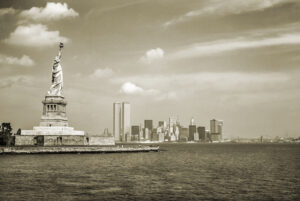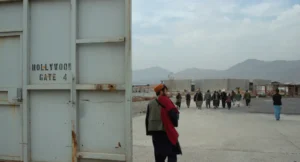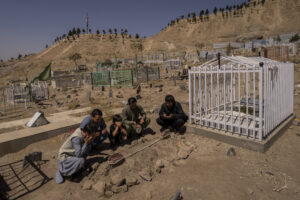American History for Truthdiggers: A Once, Always and Future Empire
The worrisome state of today's nation did not spring into existence with the 2016 election. It is a product of long historical trends. To many, the American war in Afghanistan—which on Oct. 7 will enter its 19th year—is a prime symptom of the disease of empire. Above, a U.S. Army National Guard staff sergeant in a battle zone there in 2012. (Lt. Benjamin Addison / U.S. Army)
To many, the American war in Afghanistan—which on Oct. 7 will enter its 19th year—is a prime symptom of the disease of empire. Above, a U.S. Army National Guard staff sergeant in a battle zone there in 2012. (Lt. Benjamin Addison / U.S. Army)
Editor’s note: The past is prologue. The stories we tell about ourselves and our forebears inform the sort of country we think we are and help determine public policy. As our current president promises to “make America great again,” this moment is an appropriate time to reconsider our past, look back at various eras of United States history and re-evaluate America’s origins. When, exactly, were we “great”?
Below is the 38th and last installment of the “American History for Truthdiggers” series, a pull-no-punches appraisal of our shared, if flawed, past. The author of the series, Danny Sjursen, who retired recently as a major in the U.S. Army, served military tours in Iraq and Afghanistan and taught the nation’s checkered, often inspiring past when he was an assistant professor of history at West Point.
Part 38, the final installment of “American History for Truthdiggers.”
See: Part 1; Part 2; Part 3; Part 4; Part 5; Part 6; Part 7; Part 8; Part 9; Part 10; Part 11; Part 12; Part 13; Part 14; Part 15; Part 16; Part 17; Part 18; Part 19; Part 20; Part 21; Part 22; Part 23; Part 24; Part 25; Part 26; Part 27; Part 28; Part 29; Part 30; Part 31; Part 32; Part 33; Part 34; Part 35; Part 36; Part 37.
* * *
There is a widespread belief that American history is best viewed in a linear context. The United States, the narrative goes, began as a flawed experiment in democracy—replete with slavery and bigotry at the start—but has gradually and consistently improved into a more perfect union, a millenarian nation on its way toward serving as an example for the world, a “city on a hill.” Minorities, according to this notion, may have once been oppressed but have gained equal rights and equal protection under the law; America might have conquered Indian and Mexican land but has long since set aside its imperial ways. As such, both at home and abroad, the U.S., though still imperfect, is a force for good in the world.
It’s a comforting narrative, but inconsistent with reality, with the facts and arc of our history. Progress, such as it is, has been wildly inconsistent and halting since the Anglo colonization of the eastern coast of North America. Take the plight of African-Americans. Theirs has been a history of false starts, dreams deferred and hopes enlivened only to be dashed. Consider, for example, that more blacks were U.S. House members and senators in 1877 than in 1967. In the wake of the Civil War, the reforms of Reconstruction launched African-Americans into positions of power they would not regain for nearly a century. During this time, Northern whites abandoned them to the whims of Southern bigots, and the result was Jim Crow—systemic segregation, a parallel apartheid system in the American South. A further example is that blacks finally saw their voting rights protected by the 1965 Voting Rights Act—which required the federal government to carefully review electoral procedures in the former Confederate states—only to find many of those protections stripped away by a reactionary Supreme Court early in the 21st century. Clearly, there’s very little that is progressive or linear in the journey of black Americans.
Taking such a broad view of American history further, one can cogently argue that the U.S. couldn’t even be considered a true democracy until 1965, when many blacks finally received the right to vote more than 240 years after slaves first arrived on these shores and almost two centuries after the Declaration of Independence was written. Still, few citizens think in or frame their country in those terms. Furthermore, America still runs a parallel system of governance for its remaining colonies, which Washington euphemistically labels territories. In the conquered islands of Puerto Rico, American Samoa, Guam and many others, the residents have no representation in Congress or say in the election of the presidents, who hold the power to send them off to fight and die in foreign wars. These people, in fact, represent the victims and refuse of America’s second empire.
That, indeed, is the key point. The U.S. was imperial from the first, the very moment when a band of English aristocrats in search of precious gold landed at Jamestown in what is today Virginia. Since that day in 1607, America has never ceased to be a settler-colonial empire in the vein of czarist Russia, British South Africa and modern Israel. Its manner of empire may well have changed, but its reality never meaningfully altered as the U.S. proceeded through three distinct phases of imperialism. First, from 1607 to 1897, British colonists, and then self-styled Americans, displaced and destroyed countless native peoples, eventually spreading a (perceived) superior way of life from the Atlantic to the Pacific oceans, another take, indeed, on the phrase “from sea to shining sea.” America’s relationship with conquered native peoples proceeded through phases of displacement, genocide, containment and finally confinement on often barren reservations. This legacy system remains today in what must be considered a series of internal colonies similar to South African “bantustans” and to Palestinian enclaves in the West Bank and Gaza Strip. In addition to overrunning outmatched natives, the U.S. also drummed up a war on false pretenses and proceeded to conquer the northern third of Mexico (1846-1848), even occupying its capital and forcing a regime change of its government.
In phase two (1898-1945), with the frontier “closed,” Native Americans safely confined and a truncated Mexico firmly in its place south of the Rio Grande River, expansionist Americans sought colonies across the seas. After starting another war under false pretenses in 1898, this time with imperial Spain, the U.S. snatched the massive Philippines, Cuba, Puerto Rico and a slew of Pacific islands. Finding the strange inhabitants of these lands too brown and too “barbaric” to integrate into coequal states, the U.S. ruled them first as direct colonies and then as unequal territories and commonwealths. It is instructive, indeed, that occupying American troops took to calling the indigenous peoples of these islands “niggers,” borrowing this slur from the nation’s original sin of slavery, racism and internal colonization and apartheid. That transition was seamless and continued well into the next, third, phase of American empire, in which Arabs and Muslims were quickly labeled “sand niggers” by many Americans sent to fight wars in the Greater Mideast.
After emerging from the Second World War relatively unscathed—at least in comparison with war-ravaged Europe and Asia—the U.S. sought global hegemony in phase three (1946 to the present) of its imperial journey. Rather than retreat behind its ocean boundaries, America remained militarily deployed abroad while politicians crafted a veritable national security militarist state at home. Although technology, particularly in transportation, obviated the need for physical control and direct governance of old-style colonies, the U.S.—far from eschewing empire—spread its imperial tentacles over the world. In the name, alternately, of fighting communism, spreading democracy and protecting human rights globally, the U.S. military constructed, occupied and operated from an “empire of bases.” Two decades after the 9/11 terror attacks had justified ever more blatant expansion, the U.S. military counted 800 bases in 80 countries, on every inhabited continent. The U.S. warfare state had unashamedly divided every square inch of the globe into discrete military commands overseen by generals and admirals who often serve in the manner of Roman proconsuls. At the time of writing, America, rather than offering a peaceful example to the world, is at war in at least seven countries. Post-World War II justifications and enemies may have changed from “Red” communists to brown terrorists, but the outcomes have remained remarkably consistent.
In all phases of American imperialism the empire has, inevitably, come home, often poisoning any hope for meaningful democracy, meritocracy or equality within U.S. borders. The racism and white supremacy necessary to wage wars of conquest, plunder and extermination against Indians and Mexicans not only stemmed from but added to existing currents within the expanding nation’s borders. Anti-immigrant nativism and xenophobia catapulted back to the homeland from American occupation and colonial suppression across the seas. Systems of mass surveillance perfected in the Philippines set the stage for a similar program meant to squelch dissent during the world wars and morphed into today’s tech-savvy digital “bugging” of American life. In another example, imperial counterinsurgency abroad informed the internal repressive tactics of the later “war on drugs,” waged mostly within America’s internal colonies of impoverished black and brown neighborhoods and native reservations.
During phase three of the American empire, the results of this imperial “coming home” have been immense. Permanent “terrorist” detention at Guantanamo, torture, prisoner abuse at Abu Ghraib, the Patriot Act, illegal rendition and National Security Agency wiretapping, unthinkable to many Americans before 9/11, are modern outgrowths of a consistent American imperial structure and history. Perhaps the most disturbing outgrowth of late-stage U.S. empire is the phenomenon of militarized “warrior cops,” equipped with surplus Army equipment and clothed in camouflage fatigues, policing poor communities of color like occupied territory. These law enforcement personnel, which include a disproportionate number of military veterans, have transported counterinsurgency and conventional warfare tactics into the internal colonies of America—forgotten spaces full of forgotten, and forsaken, people.
The vast, vast majority of this imperial history unfolded long before Donald Trump arrived on the national scene. It is a legacy of empire bequeathed to generations of Americans by their forefathers across the centuries. Men (and the top leaders have always been men) from each and every major American political party have built, expanded and maintained this dual structure of internal and external imperialism. Empire is perhaps the only truly bipartisan national endeavor. Furthermore, class, that most unspoken of American maladies, has often been at the root of American systems of oppression. The division of the working class along ethnic and religious lines, and then the suppression of the remaining class-conscious activists, helped make the imperial machine palatable in the first place. That an outspoken, buffoonish, billionaire businessman came to rule, to serve as de facto emperor, of the American imperial complex on the back of his claims to represent working-class people and “Make America Great Again” is indicative of the power of class cooption and racial subjugation. Supporters of Donald Trump, “deplorable” though they might be in the eyes of their opponents, when viewed in context are inherently American.
Trump in Context: Reflections of America’s Dark Side
President Trump is no aberration. No doubt the election of a shady real estate magnate, tabloid playboy and reality-TV-star-turned-xenophobic-populist was a profound matter. That said, much of the Trump effect is a modern-day reflection of America’s historical trends and baggage. In fact, with just a touch of difference, the coalition that elected Trump is a standard alliance of four distinct interest groups (and peoples) that put Republicans in office for decades and maintained American imperialism and internal oppression long before that political party had even been founded. These are anti-taxation (usually hyper-wealthy) libertarians, foreign-policy hawks with imperial proclivities, intolerant brands of evangelical Christians, and racist xenophobes. The genius of Trump, then, was not unlike that of Ronald Reagan or Richard Nixon before him. All managed to appeal to these wide and seemingly dissimilar and contradictory groups and pull them under a big tent, despite subsequently governing mainly in the interests of wealthy elites. The main glue, of course, was in racial appeals to white identity that held together, first, the Southern Democrats (1830s-1950s) and then a transformed Southern-dominated Republican Party (from the 1960s to the present).
In the area of domestic policy, Trump’s defense of white supremacist violence, harsh oppression of immigrants and refugees, reflexive support for militarized cops and refusal to act to tamp down a national epidemic of gun violence seemed to many progressive-minded Americans to be uniquely heinous. In reality, Trump and his supporters have simply rebranded older forms of racism, nativism and homegrown militarism that had long been crucial links in American society. Furthermore, as in earlier administrations, lines between what constitutes domestic and foreign policy are blurred under Trump. As such, barbed wire along the southern border with Mexico has a direct link with the walling and wiring off of adjacent neighborhoods by the U.S. military in Baghdad.
Trump’s massive tax cuts, statistically highly skewed to benefit the very rich, were far more consistent than anomalous. The massive income inequality that results from this tax revision and regular cuts to social welfare programs may be reaching record levels but is a standard aspect of American economics and not unlike the prevailing situation during the Gilded Age (1877-1914). The president’s call for a “Muslim ban,” which finally morphed into a “travel ban” against a select group of Muslim-majority countries, also has plenty of historical precedent. The Chinese Exclusion Act, the 1924 Immigration Act (which limited migration from Slavic, Jewish and Asian communities) and massive internment of Japanese-Americans during World War II are only a few of the antecedents of Trumpian policy and procedure.
In the realm of foreign policy, Trump has, it must be said, spoken and tweeted in ways that are out of step with the traditionally expansionist foreign-policy-hawk wing of his coalition’s quartet. His calls for the end of “dumb” wars and missions in the Middle East no doubt appealed to many in a war-weary public and demonstrated an earthy (if uniformed) commonsense. Still, his lack of follow-through on this front—whether due to his own dishonesty or the influence by the wildly hawkish advisers surrounding him—demonstrates the prevailing power of the national security structure, or what his supporters term the “deep state.” In practice, Trump has only increased the scale of U.S. bombing and worldwide military deployments, and even brought America to the brink of war with states as separated and diverse as Iran and Venezuela.
Nevertheless, one should not let self-styled liberals or Democratic partisans off the hook. Their manufacturing of and obsession with “Russiagate”—the so-far-unsubstantiated claim that the Trump campaign colluded with Vladimir Putin and Russian intelligence to win the 2016 U.S. presidential election—has heightened a new Cold War and, given the long, sordid history of American meddling in foreign elections, illustrated the obtuseness of the “liberal” class. Trump then expanded Cold War 2.0 to include a growing China by waging foolhardy economic warfare against Beijing. Finally, Trump’s right-wing authoritarian ambitions have not only spread to a number of foreign countries but built upon the precedents set by former American Presidents Nixon, Franklin and Theodore Roosevelt, William McKinley and even Andrew Jackson. Taken as whole and in proper context, then, Trump is an all-American president, and his promise to “Make America Great Again” is little more than a recasting of regular calls to return to the whiter, more oppressive, less equal United States of the past.
The American Future: Republic or Empire, Democracy or Oligarchy
In the light of the correct, if discomfiting, facts, one must conclude that America carries the baggage of four dark historical themes. These are genocide, racism, hypercapitalism, and empire. Today’s Thanksgiving myths to the contrary, English colonists and later self-branded Americans never seriously considered coequal coexistence with indigenous peoples. Through the spread of diseases (sometimes purposefully), wars of conquest, policies of confinement and cultural attacks on native ways of life, the U.S. devastated American Indians. By 1890, these First Peoples were nearly extinct.
Racism, which began in the form of “original sin” color and caste-based chattel slavery, not only poisoned but pervaded the American experiment. For more than half of its history, Anglo-American society built itself largely on the literal and figurative backs of black slaves. When the obscenely bloody American Civil War brought de jure slavery to an end, de facto slavery (both economic and social) continued for a century in the guise of a structural system of apartheid segregation. Even today, black poverty and a massive black-white wealth gap, as well as police suppression and institutional racism, continue to maintain a permanent African-American underclass. Furthermore, regular appeals to “law and order” throughout American history ensured that black and brown people have filled the nation’s prisons, culminating in today’s structure of mass incarceration in which more blacks are in some phase of the modern correction system than were slaves in 1861.
Capitalism, which reached its most extreme form on America’s shores, also characterized the development and progress of the United States. Generations of historians, pondering the socialism and social democratic and labor parties that developed in the Old World of Europe and across the global south, have been befuddled by the question of why there has been no widespread socialism in America. Though there are no easy answers, some have noted that a peculiar American strain of hyper-individualism, purposeful racial and ethnic divisions of the working class and pervasive attacks on labor unions combined to halt the influence of even mild forms of collectivism and social welfare in this country. Gilded Age wealth inequality mirrored colonial-era aristocracy and set the stage for today’s record degree of income disparity. American taxation has always—with one brief exception, from the 1930s to the 1960s—been exceptionally low and regressive, slanted from the first to benefit the super rich.
Empire, by now, should speak for itself. Throughout its history the United States has maintained a dual-track system of imperialism. Black urban ghettos and Southern sharecropping communities, to say nothing of Indian reservations, served and serve as monuments to internal empire. Conquered native and Mexican lands in North America and captured Spanish Pacific and Caribbean colonies personified external empire for centuries. Since the Second World War, expeditionary U.S. military basing and historically unprecedented interventionism characterized modern foreign empire. This legacy of empire has always “come home to roost,” in varying forms of nativist xenophobia, militarized policing and the squelching of internal dissent and civil liberties. Empire, for America, has always been a way of life.
In spite of it all, hope—however weakened—for a truly democratic, inclusive and peaceful America remains. The immense power of the military-industrial complex and corporate oligarchs and their misguided xenophobic and racist foot soldiers has, no doubt, only made that American dream seem more distant than ever. Nonetheless, history has consistently demonstrated the potential power of motivated people to shut down the system and force positive change. That change, that progress, however, is more unlikely than ever to come from the three foundational institutions formed by the U.S. Constitution.
The executive branch has seized so much power—especially in foreign affairs—that presidents (sometimes not even elected by a plurality of the voters) operate more like dictators than servants of the people. The legislative branch, the Congress, is stalemated by tribally partisan division, is veritably owned by well-funded lobbyists and long ago ceded its constitutionally mandated duty to declare war and oversee foreign affairs. As such, the people’s purported representatives cannot be counted on to roll back empire either at home or abroad. The courts, especially the Supreme Court, have become highly politicized and increasingly dominated by archaic, reactionary, conservative “originalists” who interpret the Constitution as though it and they were in an 18th-century time capsule. After a brief spell of progressive, activist decisions (1954-1971), the courts have rolled back minority protections and affirmative action and even—in the infamous Citizens United decision—handed over political power to the wealthiest slice of Americans. Furthermore, these unelected judges have refused to weigh in on the legality of U.S. imperial policy and presidential war-making abroad.
Change, reform, revolution even, must explode from the grass roots, from organized people power. The precious, highly lauded institutions of American representative democracy have failed the people yet again. Only new collectivist bodies, egalitarian citizen groups, can wield the power to demand a new path for the nation. The odds are stacked against them, no doubt. Those who control the current system count on citizen apathy, reinforce it even, and know they cannot continue indefinitely to hold the reins without it. The owners of this country—the corporations and their proxy politicians—fear a cross-class, multicultural movement by poor and working people more than anything. Power rightfully belongs to the people, was promised to them by America’s very founding document. After all, the preamble to the Constitution stipulates that the government exists to serve not the states, the rich, the corporations or the military, but the American people. They can seize control of their collective destiny if they have the courage and the will to take it.
* * *
To learn more about this topic, consider the following scholarly works: • Kevin M. Kruse and Julian E. Zelizer, “Fault Lines: A History of the United States Since 1974” (2019). • Jill Lepore, “These Truths: A History of the United States” (2018).
Danny Sjursen, a regular contributor to Truthdig, is a retired U.S. Army officer and former history instructor at West Point. He served tours with reconnaissance units in Iraq and Afghanistan. He has written a memoir and critical analysis of the Iraq War, “Ghost Riders of Baghdad: Soldiers, Civilians, and the Myth of the Surge.” He lives in Lawrence, Kan. Follow him on Twitter at @SkepticalVet and check out his podcast, “Fortress on a Hill,” co-hosted with fellow vet Chris “Henri” Henrikson.
Your support is crucial...As we navigate an uncertain 2025, with a new administration questioning press freedoms, the risks are clear: our ability to report freely is under threat.
Your tax-deductible donation enables us to dig deeper, delivering fearless investigative reporting and analysis that exposes the reality beneath the headlines — without compromise.
Now is the time to take action. Stand with our courageous journalists. Donate today to protect a free press, uphold democracy and uncover the stories that need to be told.






You need to be a supporter to comment.
There are currently no responses to this article.
Be the first to respond.